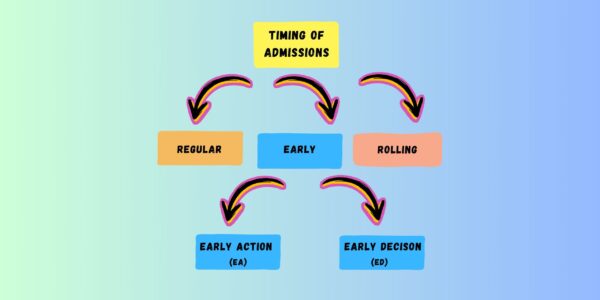Timing of Decisions
When applying to college, it’s important to make several strategic decisions, one of which is selecting application deadlines carefully. You need to determine whether to apply during the early admission cycle or the regular admission cycle.
Applying early can significantly increase your chances of acceptance. For instance, in the last admissions cycle, Harvard had an overall acceptance rate of 3.59%, while the acceptance rate for early applicants was 8.74%. Yale University’s overall acceptance rate was 3.7%, but early applicants were accepted at the rate of 9%. Cornell’s figures were even more impressive, with an overall acceptance rate of 6.9% compared to 18.2% for early applicants.
If you choose to apply early, it’s essential to understand the different types of early admission processes available:
- Early Action (EA): This nonbinding process allows students to apply earlier than regular deadlines, typically between October 15 and November 15, with many schools’ deadlines around November 1. Students receive decisions by mid-December and must respond by the regular decision deadline, usually May 1. MIT and Georgetown are examples of universities that offer Early Action.
- Restrictive Early Action (REA): Some schools have introduced this variation of early action, which has a slight modification compared to standard EA. While still nonbinding, students who choose REA cannot apply to any Early Decision schools but can apply to other EA schools. Harvard and Stanford are examples of institutions that offer REA.
- Single Choice Early Action (SHEA): This is another variation of early action, allowing students to apply early to their top-choice school. However, if students apply to a SHEA school, they cannot apply to any other EA or ED schools. Princeton is an example of a school that offers SHEA.
- Early Decision I (ED I): This is a binding process for applying early to a student’s first-choice school. If admitted, the student is required to attend that college. The University of Pennsylvania was among the first to offer this process, which is now available at many institutions, including Northwestern, Brown, and Columbia.
- Early Decision II (ED II): This option also represents a binding early application process for a first-choice school, with decisions released early. The key difference from ED I is the application timing; ED I deadlines are typically around November 1, while ED II deadlines are closer to regular decision deadlines, usually around January 1. Students may apply ED II if they missed the ED I deadline or if they were declined or deferred. The University of Chicago offers ED II.
While early admissions present numerous advantages, if you miss the early deadlines or are deferred or declined, you still have the option to apply through a regular decision process.
Regular Decision (RD): This nonbinding process allows students to apply to any school of their choice. Regular admission deadlines vary by institution but are generally in early January.

